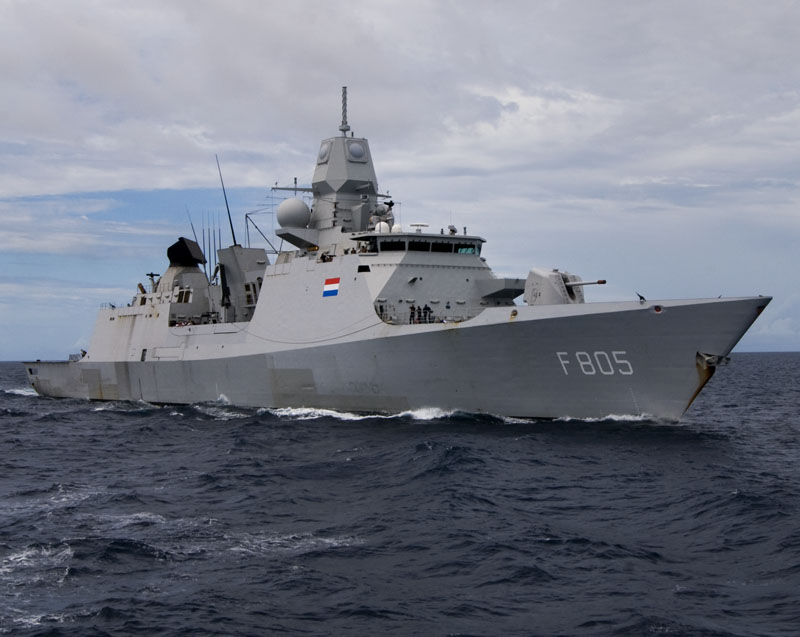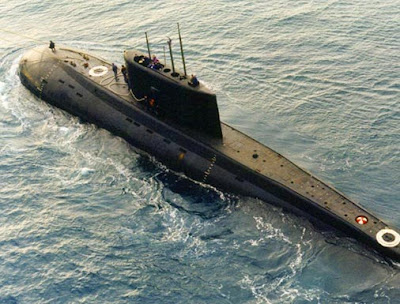Usually, we cover the air – in this blog post we’ll do a short “water excursion”. There are many different ships in the world’s navies today. They all have different applications and some classifications are exclusive to certain countries. Different countries have put their effort into different kinds of ships and some have invested in almost all of them. For the reader with basic knowledge, we try to shed some light on to that classification. In this article, we will look into the different types of surface and submerged vessels and what navies operate them. The first ship on the list: Frigate.
Frigates

De Zeven Provinciën-class air-defence and command frigate of the Royal Netherlands Navy.
Frigates are usually regarded as ships weighing more than 3000 tons. Its role is to protect other ships of its strike group, the main part of this responsibility is to protect them from hostile submarines. The Frigate does not have any actual definition which means that they have similarities to corvettes, destroyers and even cruisers. The Littoral combat ships are by some regarded as frigates.
Corvettes

HSwMS Helsingborg of the Swedish Visby class. It features a stealth hull which decreases its radar cross section by 99%.
A Corvette is a small warship with light arms. Due to this and their high maneuverability they are great in smaller seas, the Red Sea for instance, which is an important reason – along the comparably low cost – many of the world’s navies operate them (just to give you some examples: The US, Argentina, Bangladesh, Brazil, Bulgaria, China, Denmark, Germany, Egypt, India, Indonesia, Iran, Israel, Italy, Pakistan, the Philippines, Poland, Portugal, Romania, Russia, South Korea, Sweden, Turkey… Due to Russia being connected to many smaller seas they have invested a lot in Corvettes and are by that the world’s biggest operator of corvettes.
Destroyers

American destroyer USS Winston S. Churchill of the Arleigh Burke class.
Destroyers are among the widely used ships in the world due to their wide range of use. Their combination of high firepower and high endurance make them ideal for both wars, escort and (other) peace-keeping operations. The name “Destroyer” comes from the Russo-Japanese war in the early 20th century where they were named “Torpedo boat destroyer”. Today they are the heaviest surface combatants after the cruiser.
Cruisers

The Ticonderoga-class cruiser USS Cowpens fires its missiles.
Cruisers – The cruiser is the strongest of them all. It is built to have great firepower and to be able to take out everything that its strike group can face. Due to its high cost and narrow mission capability, only the US, Russia and Peru (old ships) operate them. The line between cruisers and destroyers is not very obvious due to some of the new destroyers (DDG-1000 for instance) having greater firepower than some cruisers.
Amphibious Assault Ships
.jpg)
A Tarawa class amphibious assault ship of the USN shows its good deck.
These ships are warfare ships used to support ground troops in forms of ammunition, transport, refuelling of vehicles and to protect them from incoming enemy aeroplanes and surface vessels. Most of them have both a helicopter deck (where VTOL aeroplanes such as the F-35 as well as helicopters can disembark from) and a good deck where small amphibious vessels can be maintained and repaired. Some of them are regarded as aircraft carriers, for instance, the Japanese aircraft carriers Izumo has been renamed to “helicopter destroyer” even though it looks like an aircraft carrier.
Aircraft Carriers

Admiral Kuznetsov of the Russian Navy.
The definition of an aircraft carrier is “A large naval vessel designed as a mobile airbase, having a long flat deck on which aircraft can take off and land at sea”. Just as the definition says it is used as a naval base and aircraft operation centre. The aircraft carriers are the biggest military ships in the world with some weighing over 100 000 tons and the capability to house almost 6000 men. An alternate name of carriers is Supercarriers which is the name of aircraft carriers weighing more than 66 000 tons. The only country that operates more than 2 aircraft carriers is currently the United States (10 active).
Littoral Combat Ships

USS Freedom (back) and USS Independence (front) are both littoral combat ships of the US Navy.
Littoral combat ship – A small class of ships specialised to operate in zones with very shallow waters where other, bigger ships cannot be used. Under this name, there are only a few operational and they all belong to the US Navy. According to the United States Navy’s webpage, the LCSs are “envisioned to be a networked, agile, stealthy surface combatant capable of defeating anti-access and asymmetric threats in the littorals”. They were also built to be a complement for the new DDG-1000 and future cruisers. The American Littoral combat ships are sometimes regarded as big corvettes.
Submarine – Attack

Dolphin-class of the Israeli Navy.
Attack submarine is the submarine type designed to take out other submarines and surface ships. They all use torpedoes to hunt their prey and some use cruise missiles in VLS to have an even greater range of targets. Due to their low visibility, they are great to protect friendly ships and to gather information about the enemy.
Submarine – Ballistic Missile

Submarine of the US Ohio class – one of its ballistic missiles is 150 times more powerful than both the Nagasaki and Hiroshima bombs combined.
This type of submarine is specialised to go out on the sea, hide, and then launch SLBMs with nuclear (or conventional) warheads to take out strategically important enemy targets. The second-strike capability was to ensure the “no first use” of nuclear weapons during the Cold War. Strategic submarines are the traditional – but expensive – method of providing a second strike capability. The other one would be “Launch on warning”. The new nuclear submarines can stay out at sea for months, at any instance being able to launch a missile of mass destruction from thousands of kilometres away. Due to this, all of the modern ballistic missile submarines have nuclear reactors as the energy source which gives them a nearly “unlimited” range.
Submarine – Cruise Missile

Kilo class cruise missile submarine.
A cruise missile submarine is a submarine that can launch cruise missiles (SLCMs). They have extreme firepower, for instance, the cruise missile submarine class Ohio can launch 154 cruise missiles without refuelling nor re-arming. The earlier types of cruise missile submarines had to surface before launching their missiles but that problem has been fixed and they can now launch their missiles without being seen with the naked eye.
Countries using the different types of ships (this info might come to change):
| Type: | Countries operating them: | Example of ship: |
| Frigate | United States, Australia, Canada, China, Croatia, Denmark, Germany, India, Iran, Italy, Malaysia, Myanmar, Netherlands, New Zealand, Norway, Pakistan, Philippines, Romania, Russia, Singapore, South Africa, Spain, Turkey, Taiwan, United Kingdom. |
|
| Amphibious assault ship | United States, France, Russia, South Korea, Spain, Australia, United Kingdom. |
|
| Destroyer | United States, United Kingdom, Italy, France, Canada, India, China, Japan, South Korea, Russia. |
|
| Aircraft carrier | United States, India, Italy, China, Spain, France, Russia, Brazil, Thailand. |
|
| Littoral combat ship | United States |
|
| Cruiser | United States, Russia, Peru |
|
| Corvette | United States, Argentina, Bangladesh, Brazil, Bulgaria, China, Denmark, Germany, Egypt, India, Indonesia, Iran, Israel, Italy, Pakistan, the Philippines, Poland, Portugal, Romania, Russia, South Korea, Sweden, Turkey. |
|
| Attack submarine | United States, Russia, India, France, China |
|
| Ballistic missile submarine | United States, France, China, Russia, United Kingdom. |
|
| Cruise missile submarine | United States, Russia, United Kingdom, Israel, India, China. | US Ohio-class Israeli Dolphin-class |

Picture of the US Norfolk Naval Base.
Norfolk Naval base in Virginia (US) is the largest American naval station where many of the US Navy’s vessels are stationed. Explore the Norfolk Naval Base here: https://goo.gl/maps/bHoh8
As can be seen, many of the definitions go into each other with some ships belonging to several of them (for instance the LCSs). The definitions are no “rules” but more like general guidelines to get some kind of system and organisation. Of course, the ships of the same classification can differ a lot due to age, cost and the environment they are built for. What can be seen is that the smaller ships with larger areas of use are present in many navies, whereas the bigger navies with bigger financial support have ships that are both bigger and built for specific tasks. One country like that is the United States which has ships belonging to every group presented in this article.
Additional Reading:
- Read a three-part series about aircraft carriers here.
- Read about the F-35 that can be used on Amphibious assault ships due to its STOVL properties here.
- Read the story of Russian aircraft carriers here.
An overview for orientation of the text above:
Sources:
- Nvr.navy.mil
- Globalsecurity.org
- Navysite.de
- wweb.archive.org
- Dictionary.reference.com
- Naval-technology.com
- Janes.com/defence



Very good
i agree
There are 2 things I want to bring up. While I understand you are primarily an aviation related site, the ability to know and recognition not only US but the surface vessels of other countries is paramount in pilots, combat pilots at least. If given a mission to provide air support for a frigate, but it’s traveling with other vessels. Sure you might be able to figure it out given dedication, but not fast enough in a combat situation. Just my $.02, and opinion. We all know what that means. Secondly, and based on fact, you need to update your vessel type/country list. The UK CURRENTLY has 2 brand new Queen Elizabeth class Carriers, the namesake HMS Queen Elizabeth & the recently launched HMS Prince of Wales. Verification is at the Royal Navy site https://www.royalnavy.mod.uk/the-equipment/ships. Along that same line, wouldn’t/couldn’t the UK’s “Patrol Boat’s” be considered their definition is VERY similar. Just a thought.
Apologies, allow me to correct the missing words
Wouldn’t/couldn’t the “Patrol Boats” be considered Corvettes as their definition is VERY similar.
You’ve commenced with what are modern day ships of the line. Fast attack/RIBs make SoL redundant unless in deep water which is why the UK use destroyers as the overt force. Subs are based on time at sea against overall firepower therefore three categories, Hunter killer, stalker and predator (generally used as last resort ie atomic ICBM).
RIBS and fast patrol are the mainstay of a nations overt defence, I’d like to see a list where they are also included.
I needed some basic information on navy ship types for a space-battle RPG game project in development, and you exceeded my expectations even at a layman level. Thank you for the assist, and keep up the great work!
Why Greece is not on the list